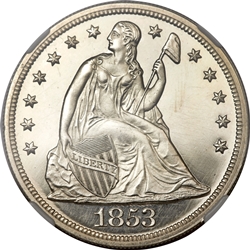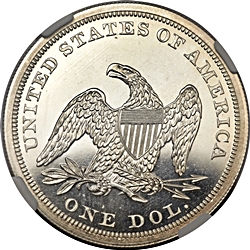 |
1853 
 |
 |
General CommentsThe finest known business strikes are three MS66 examples, two graded by PCGS and one by NGC. PCGS has graded two additional coins MS65. NGC has graded a single example at that level. One or two of these may be duplicates. A total of 52 coins have been graded at the MS64 level. The huge jump in the MS64 population almost certainly indicates multiple attempts to get MS64 coins upgraded to MS65. A total of 160 coins have been graded at all mint state levels. As with most dates in the 1850’s finding a certified coin at the lower end of the grading scale can be just as difficult as finding a gem. PCGS has graded only 17 coins at VF grading levels, and only 11 below that. NGC has graded only 4 VF coins, with only one lower. The collector developing a set at the VF or lower level will have to be patient to locate an example of this date. Population statistics are as of January, 2019. |
|
High-grade business strikes are almost always frosty. We can’t recall seeing a fully prooflike example. We don’t believe that the business strike obverse die was used for striking proofs, and thus was probably never fully polished. All proofs currently known have been classified as restrikes (more later). The finest known is a single PR66 Cameo graded by NGC and granted a star for eye appeal. PCGS has graded one coin PR66. NGC has graded one coin PR65. PCGS has seen none at that level. A total of 12 proofs have been graded at all levels of preservation. Two of these are lightly circulated.
1853 Proofs
1853 proofs, as with the other dates in the early- to mid- 1850’s, merit a separate discussion. Estimates of the proof mintage vary from 12 to 25. We believe that 20-25 is a good estimate, with less than 15 surviving today. The existing literature has fairly consistently identified 1853 proofs as restrikes, probably minted in the early 1860’s, with most acknowledging that originals were struck.
All proof examples that we’ve been able to confirm, either by direct examination or from pictures, have been struck from the same pair of dies, neither of which was used to strike business strikes. As noted above, these have almost universally been identified as restrikes. If we assume that the restrike attribution is correct, and apply what we’ve learned from the other dates prior to 1855, we would assume that there’s probably a small number of original proofs out there somewhere that pair the 1853 proof obverse with Reverse 1840 PA. This reverse die was used to strike original proofs for every year from 1840 through 1854, with the possibly exceptions of 1851 and 1853. We’ve left a place for this unconfirmed die pair in our die marriage listings, calling it OC-P1. We’ve identified examples from the confirmed die pair, the die marriage almost always attributed as a restrike, as OC-P2.
The question remains – are 1853 OC-P2 examples originals or restrikes? As we’ve done with the other dates in the early 1850’s we’ve chosen to keep an open mind. We’ve examined the dies to see what they tell us.
Our first effort was to determine when the 1853 dies might have been created. We looked at the 4-digit logotype used to create the proof die. While we can’t confirm that the punch was the same, it’s clear that the logotypes used to create the business strike and proof dies are identical. Thus, the punch was likely created in 1853 or in preparation for that year’s coinage. This doesn’t confirm that the 1853 proofs are originals, but it reduces the probability that the obverse die was created later. It also fits with the fact that two obverse dies were created for 1853 (reference 4).
Next, we looked at the die used for the reverse of the 1853 proofs to see if it was used in other years. All other restrikes (with one exception in 1854) paired the obverse die with a reverse that was first used to strike original proofs in a later year. We think we’ve identified almost all the reverse dies used for proofs for the entire series. We found no match to the reverse die used for the 1853 proofs. It’s unique to 1853. This would support a conclusion that the 1853 proofs are originals.
Further support for the conclusion that 1853 proofs are originals comes from our analysis of the proof restrikes of 1851, 1852, 1854, and 1858. All these restrikes (with one exception in 1854) paired the obverse dies with one of three reverses that were first used in later years – Reverse 1856 PA, Reverse 1859 PA, and Reverse 1865 PA. None of these reverse dies have been found on proof dollars dated 1853. This makes it unlikely that the 1853 proofs were created at the same time as the other restrikes.
In summary, our analysis of the 1853 dies supports the attribution of 1853 proofs as original, but nothing is conclusive.
We also looked at other supporting information. The late David Akers felt that NO 1853 proof coinage was original (reference 17). This would clearly identify the 1853 dollars as restrikes. The interested reader should also examine reference 16, which includes much additional information, all of it inconclusive. We must leave the subject with the jury still out. There’s no definitive answer, at least currently, to the question of whether the 1853 proofs are original or restrike.
1853 proofs are usually found with strikes that are good to strong. Whenever the coins were minted, whether in 1853 or later, there were apparently two different strikings, with the obverse die lightly polished between the strikings. The earlier strikes seem to be very strong, the later ones show slight weakness on the upper edge of the eagle’s left wing. Obverse strikes are strong on all examples seen.
1853 Die Marriages
We’ve identified a total of 3 die marriages for 1853, 2 proofs and one business strike. The first proof die marriage is the unconfirmed original issue, but we’ve left a place for it in our die marriage listings. The following table summarizes the known die marriages:
Die Marriage |
Rarity |
Obverse Die |
Reverse Die |
Estimated Survivors |
| OC-1 | R2 | 1 | A | 1000 |
| OC-P1 | Unconfirmed | Unconfirmed | 1840 PA | 0-3? |
| OC-P2 | R7- | P1 | PA | 12 |
A single pair of dies was used to strike all business strikes. We’ve identified this die marriage as OC-1. Neither die was used for proofs. Most examples seen exhibit light obverse clash marks in the field under Miss Liberty’s arm. The reverse die is almost certainly clashed also, but the clashing is very light. A vivid imagination is required to detect it. We assume that there’s an early unclashed die state out there somewhere, but they’re apparently very rare.
Our die marriage array includes two proof die pairs, but only one is confirmed. OC-P1 pairs an unknown obverse die, probably Obverse P1, with Reverse 1840 PA. This reverse die was used to strike original proofs in every year from 1840 through 1854, with the possible exceptions of 1851 and 1853. For this reason only we expect that there are probably one or more original proofs out there somewhere, so we’ve left the place for it in our die marriage array. The confirmed proof variety, OC-P2, pairs obverse and reverse dies that are unique to 1853 and to this particular die marriage. This die pair has been identified as a restrike for many years, but as discussed earlier in this section the evidence for original vs. restrike is inconclusive.
1853 Business Strike Emission Sequence
With only one business strike die marriage the emission sequence is simple.
Emission Order |
Die Marriage |
Comments |
| 1 | OC-1 |
1853 Proof Emission Sequence
We assume that the original proof, if it exists, is first in the emission sequence.
However, until an example of OC-P1 is confirmed, this emission sequence is uncertain. It is known that the
small number of 1853 proofs, our die marriage OC-P2, were minted in two different strikings.
It’s unknown whether these strikings were on the same day or at different times.
Emission Order |
Die Marriage |
Comments |
| 1 | OC-P1 | If it exists this original proof issue would likely be first in the emission sequence |
| 1 | OC-P2 | Until an example of OC-P1 is discovered it's impossible to conclusively determine whether OC-P2 is first or second in the emission sequence. |
1853 Quick Finder Chart
1853 die marriages are easy to attribute. Each die has unique characteristics that allow easy identification. The key points are listed in the table below.
Die Marriage |
Obv. Die |
Rev. Die |
Right Base |
Keys to Identification |
| OC-1 | 1 | A | C | Obverse: High date. Base of 1 is C. Reverse: Numerous fairly heavy die polish lines slant up to the right in the shield recesses. |
| OC-P1 | Unknown | 1840 PA | Unknown | Obverse: Unknown. Reverse: Defects inside the upper triangle of A3. |
| OC-P2 | P1 | PA | RE | Obverse: Heavy die lines below and above date. Base of 1 is RE. Reverse: Die line on the rim above NI. No die lines in the shield recesses. |
| Photo credits:
Obverse and reverse full photos: NGC PR66 cameo, ex. Pittman/ Kaufman, from the Heritage archives. |
